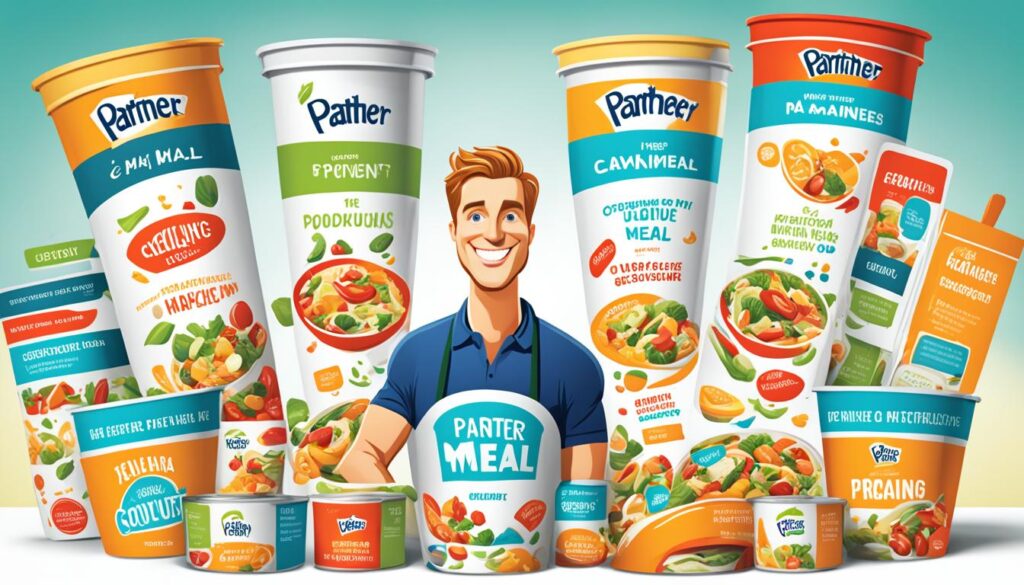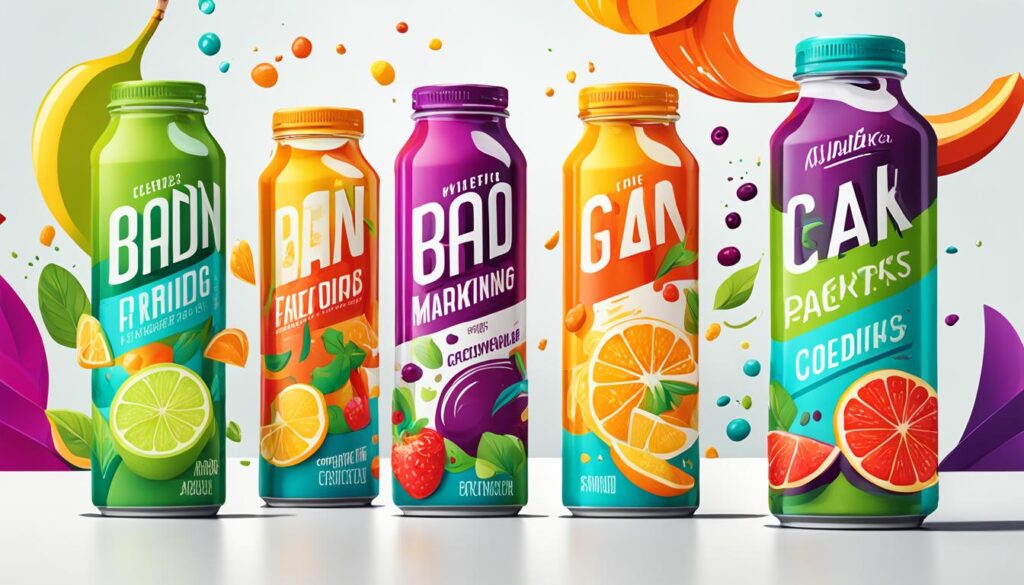In the world of convenience foods, packaging design is key to grabbing attention and boosting sales. It’s a crucial part of marketing strategy. Effective packaging can change how a product stands out on shelves. Partner In Convenience Food knows how to make packaging that protects the product and shares the brand’s story and value.
Packaging isn’t just about looks; it’s a strong marketing tool that shapes how people think and act. In the convenience food industry, smart packaging design helps products stand out, build brand awareness, and grow market share. Every detail, from graphics to labels, matters in creating a strong brand experience.
The Role of Packaging in Marketing
Packaging is key in marketing. It helps attract customers, share what the brand is about, and change how people act. In today’s market, good packaging can make a product stand out and increase sales.
Packaging acts like a silent salesperson. It’s often the first thing people see when they look at a product. So, it’s important for grabbing attention and sharing important info. Things like bright colors and clear messages can make people choose one product over another.
Packaging also helps share a brand’s values and personality. By choosing the right materials and designs, companies can make their brand stand out. This makes people remember the brand and feel connected to it.
Good packaging can make people feel happy and think positively about a brand. It can show quality, style, or fun, depending on what the brand wants to be known for. This can make people buy more and come back for more.
In the convenience food world, packaging is even more important. It needs to draw in customers, share the brand’s identity, keep food safe, and make it easy to use. New packaging ideas, like containers you can seal again or single servings, can make using the product better and set it apart from others.
Companies need to stand out, so good packaging is key to marketing success. Using packaging to share the brand, change how people act, and make products unique can make a big impact. This can help businesses grow and make more money.
Elements of Effective Packaging Design
Making a good packaging design is all about balancing looks, function, and brand message. The right mix of these elements creates a product that grabs attention and shares the brand’s special offer.
Graphics, colors, and typefaces are key to packaging design. They must match the brand and appeal to the target audience. Bright colors make a product pop, while calm tones can show off a sophisticated or simple style, fitting the brand’s image.
But packaging isn’t just about looking good. It must also be practical. People want packaging that’s easy to open, keeps things safe, and doesn’t break easily. For foods meant to be eaten on the go, it should also be microwave-safe and easy to close again.
Labels on packaging are super important too. They should be clear and easy to read, listing the product name, what’s in it, and how to use it. Being open and clear helps build trust with customers, letting them know they’re making a good choice.
By mixing good looks, usefulness, and a strong brand message, packaging can be a powerful marketing tool. It draws in customers and strengthens the brand. As more people lead busy lives, packaging that’s easy to use and safe for microwaves will be key.
Understanding Your Target Audience
To make packaging designs that connect with people, knowing your audience well is key. Through detailed market research, companies learn about what consumers like, how they shop, and what affects their choices.
Understanding what your audience wants and needs is crucial. For instance, busy people might look for easy-to-use products. Health-focused buyers might want packaging that shows off healthy ingredients. By designing with these needs in mind, companies can make products that stand out and keep customers coming back.
Good market research uses both numbers and people’s thoughts. Surveys, focus groups, and interviews help companies understand what their audience likes and buys. This info helps designers pick the right colors, fonts, and images for their products.
Culture also shapes what people like in packaging. What looks good in one culture might not work in another. So, companies must think about cultural differences when designing for various groups.
By really getting to know their audience, companies can make packaging that grabs attention and shares the special benefits of their products. This approach can boost sales, loyalty, and success in the market.
Partner In Convenience Food
In today’s fast world, people want quick and easy meals without losing quality or taste. Partner In Convenience Food is a top supplier for these needs. They offer a wide range of products and services for retailers, foodservice operators, and airlines.

They do more than just supply food. They work closely with clients to create high-quality, easy food options. Their team helps with everything from snacks to private label manufacturing, including packaging design.
They know how important packaging is for marketing and brand identity. So, they help clients design packaging that protects the product and shares the brand’s message. They use their knowledge of what consumers like and market trends to make packaging that grabs attention.
Partner In Convenience Food is known for their focus on quality, innovation, and customer service. They’re a trusted partner for businesses wanting to offer convenient food options. With their help, businesses can stay competitive and meet the changing needs of consumers.
Packaging as a Brand Touchpoint
In today’s market, packaging is key to connecting with customers and building loyalty. Brands that keep their packaging consistent across products stand out. This consistency helps build a strong brand identity and sticks to their values.
By having a unified look, brands become familiar and trustworthy to customers. This leads to happier customers and more repeat buys.
Daily Harvest is a great example of using packaging to connect with customers. It focuses on organic fruits and veggies for health. This approach has made it popular, with 16% of people willing to try its food delivery service.
Before even hitting retail stores, Daily Harvest was known by about 40% of people. Its consistent packaging design has been a big part of this success.
Daily Harvest’s packaging does more than just share its values. It also engages customers. Through its direct sales model, it learned a lot about what customers like and bought again. This info helps shape its retail products.
As Daily Harvest grows, it’s making more of its products available in stores. This has made customers happy to buy them during their regular shopping trips.
Well-designed packaging can also make customers interact more with a brand. Things like QR codes, augmented reality, or social media campaigns can make the brand experience last longer. This creates a stronger bond between customers and the brand.
Daily Harvest is growing by focusing on getting new customers to try and buy more. It uses special campaigns and works with retailers like Instacart. By tailoring its approach to each store and customer, Daily Harvest shows how packaging can build a loyal customer base.
Packaging Design Trends

Consumer tastes and tech are changing, making packaging trends shift too. Now, there’s a big push for eco-friendly and simple designs to cut down on waste. Brands are choosing packaging that can break down or be recycled, like plant-based plastics or paper, to win over eco-aware shoppers.
Clean and clear designs are also big in packaging now. People want to know what’s in their products, so packaging is getting simpler. This fits with the trend for natural and organic products, as folks put health and wellness first.
Personal touches in packaging are becoming more common. Brands are using tech to make their packaging stand out and connect with customers on a deeper level. For instance, Coca-Cola’s „Share a Coke” campaign used names and phrases on bottles to offer a personal touch.
Technology is also changing packaging. With QR codes, NFC tags, or augmented reality, brands can share more with customers. This tech not only makes shopping more fun but also helps brands learn about their customers and market better.
As packaging trends keep changing, brands need to keep up with what their customers like. By focusing on being green, simple, personal, and tech-savvy, brands can make packaging that does more than just protect products. It can also draw in and keep customers in a crowded market.
Integrating Packaging into Your Marketing Mix
To make the most of packaging design, it must blend well with the marketing mix. This means packaging should match the company’s marketing plans, like ads, promotions, and online marketing. By using packaging images and messages in different marketing ways, companies can make a strong brand experience. This helps highlight the main product benefits.
Creating cross-channel marketing campaigns with the packaging design is a smart move. It boosts product awareness, gets people to try it, and builds loyalty. For instance, Sow Good, a top farm company, saw a 37% revenue jump in Q2 2024, from $1.3 million to $15.6 million. Their packaging promotion efforts were key to this growth.
Packaging is a great way to promote products too. Things like special edition designs or seasonal packaging can make customers excited and prompt them to act fast. Sow Good’s creative packaging and strong financials (making $3.3 million in net income and $6.2 million in adjusted EBITDA in Q2 2024) show how packaging can boost marketing.
When planning integrated marketing communications, remember packaging’s role in engaging with customers and driving sales. Using packaging as a key point and keeping it consistent across all marketing can greatly increase the effect of packaging design. This helps meet marketing goals.
Measuring the Impact of Packaging Design
It’s key to check how well packaging design works to make smart choices and improve future designs. By looking at sales, market share, and what customers say, companies learn a lot. They see how their packaging affects their product’s success.
Looking at sales before and after a packaging change shows how the new design changes consumer behavior. This helps businesses understand what drives people to buy more.
For deeper insights, companies use surveys and focus groups. These methods show how things like color, graphics, and how easy it is to use affect customers. By listening to what consumers say, companies can make their packaging better.
A/B testing is also a great way to see how packaging design works. By testing different designs, companies find out what sells more and grabs attention. This helps them refine their designs to better match their brand and appeal to their audience.
Keeping an eye on how well packaging works is key to staying competitive. By using data from sales, customer feedback, and A/B testing, companies can always make their packaging better. This leads to more market share, happier customers, and growth over time. Good packaging design is an investment in the future of a business.
Case Studies: Successful Packaging Designs
Looking at packaging design case studies shows how companies have boosted their brands and sales. PepsiCo’s 2009 redesign of Tropicana orange juice packaging is a great example. They made it clean and modern, focusing on the natural ingredients. This led to a big increase in sales.
Kellogg’s Special K cereal packaging got a new look in 2010. It was made more modern and appealing. This change drew in new customers and made the brand fresh again. It shows how knowing your audience and their likes is key.
Dove’s „Real Beauty” campaign changed how they showed beauty on their packaging. They used real women of different ages, sizes, and backgrounds. This move not only boosted sales but also made Dove stand out for promoting body positivity and inclusivity.
By looking at these examples, companies can learn how to make their packaging better. From highlighting what makes the product special to matching with what consumers value, the right packaging redesign can make a big difference. It can help brands grow and stand out in a crowded market.
Conclusion
Applebee’s and Central New York schools are facing tough times. Applebee’s saw a 1.8% drop in sales in Q2 and plans to close up to 35 locations in 2024. This is because more people are choosing to cook at home instead of eating out.
Even with a focus on value, Applebee’s is finding it hard to keep its restaurants open. Central New York schools are looking at merging buildings due to a drop in students. They could save $117,000 a year by closing one school and need over $3 million for upgrades elsewhere.
Parents support this move to make things easier for students and to get more involved. Applebee’s and schools are making hard choices to adapt to economic and demographic changes. Talking to customers and the community will be key to finding solutions that meet everyone’s needs.

